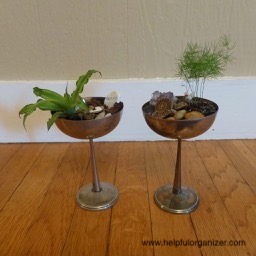 Letting go of things can be stressful and difficult, especially if they hold some sentimental value. We tend to hold onto things that remind us of precious people and moments from our past. A few years ago I was helping a client organize her bedroom, and we came across some dried, brittle, dusty, yellowed flowers in a vase. She explained that it was her dried wedding bouquet, and she wanted to keep it. I asked her to pause for a moment and tell me objectively what she saw. She did. I then asked to tell me about other mementos she had from her wedding day. When she was finished she understood what I was getting at and said “I think I can let the flowers go.” She understood that although her wedding flowers were an important part of her wedding day, now they were just dust collectors. Since she had other more meaningful mementos from her wedding day, as well as photos of the flowers when they were vibrant and beautiful, she could let go of the brittle, dusty, yellowed version. By taking a moment to look and think objectively we can all make better choices about letting go.
Letting go of things can be stressful and difficult, especially if they hold some sentimental value. We tend to hold onto things that remind us of precious people and moments from our past. A few years ago I was helping a client organize her bedroom, and we came across some dried, brittle, dusty, yellowed flowers in a vase. She explained that it was her dried wedding bouquet, and she wanted to keep it. I asked her to pause for a moment and tell me objectively what she saw. She did. I then asked to tell me about other mementos she had from her wedding day. When she was finished she understood what I was getting at and said “I think I can let the flowers go.” She understood that although her wedding flowers were an important part of her wedding day, now they were just dust collectors. Since she had other more meaningful mementos from her wedding day, as well as photos of the flowers when they were vibrant and beautiful, she could let go of the brittle, dusty, yellowed version. By taking a moment to look and think objectively we can all make better choices about letting go.
Here are 7 options for letting go that will help you keep the memories but not the stuff.
- Keep only the best of photographs, artwork & hand-made crafts to bring greater value to the memory.
- Set limits (container limit or quantity limit)
- Set criteria (most meaningful, most representative of personality)
- Go digital with photos, memorabilia, artwork
- Share and send photos to family/friends
- Keep part of a set or collection: china, glass items, collectables, furniture, nick-knacks & tchotchkes, holiday decorations & decor to bring ease to maintenance.
- Get items appraised to understand value

- Set limits (keep half, the best 3, most memorable)
- Establish a specific place for display or specific use
- Reduce what you keep (just signatures on greeting cards, every 5th year of journals)
- Get creative, re-purpose or reuse to bring new life to items.
- Re-purpose dishes and stemware as planters or jewelry holders
- Re-purpose china to make jewelry or mosaic art pieces
- Reuse fabric from items to make quilts, pillows, teddy bears, mittens, bags, Christmas stockings or other items
- Use paper items to make place-mats, wrapping paper, greeting cards
- Take photos and videos to preserve visually and digitally.
- Create digital scrapbooks to share the memories and stories

- Use as a screen saver on computer or phone
- Consolidate images into collages
- Share and document story of item to preserve memory.
- Use on-line digital options to share stories and photos
- Share stories and memories of items verbally at family gatherings
- Star in a video sharing stories and memories of family heirlooms
- Find worthy recipient to ease guilty feelings.
- Search on line for specific worthwhile charities
- Ask family, friends, and social media connections for willing recipients
- Accept that we may not be able to find the perfect recipient and let it go believing the next owner will cherish it
- Experiment and practice letting go.
©September 2018 Janine Cavanaugh, Certified Professional Organizer®
 Whether you have a bit of clutter, or a full blown mess, the best first step to organize it is to sort and categorize. Separating items into groups of similar things is the easiest way to start any organizing project. Creating categories in which to sort items is always the first action I take when starting any organizing project. For example five categories used for clutter that had collected on a client’s table are; unopened mail, papers to address, stuff to read, items to address, and items to be put away. Categorizing the clutter allowed us to address each of the 5 groups one at a time. This moved the organizing process along successfully. So, the next time you feel stuck or unsure of of where or how to start an organizing project remember categorizing is the best first step.
Whether you have a bit of clutter, or a full blown mess, the best first step to organize it is to sort and categorize. Separating items into groups of similar things is the easiest way to start any organizing project. Creating categories in which to sort items is always the first action I take when starting any organizing project. For example five categories used for clutter that had collected on a client’s table are; unopened mail, papers to address, stuff to read, items to address, and items to be put away. Categorizing the clutter allowed us to address each of the 5 groups one at a time. This moved the organizing process along successfully. So, the next time you feel stuck or unsure of of where or how to start an organizing project remember categorizing is the best first step.




 Letting go of things can be stressful and difficult, especially if they hold some sentimental value. We tend to hold onto things that remind us of precious people and moments from our past. A few years ago I was helping a client organize her bedroom, and we came across some dried, brittle, dusty, yellowed flowers in a vase. She explained that it was her dried wedding bouquet, and she wanted to keep it. I asked her to pause for a moment and tell me objectively what she saw. She did. I then asked to tell me about other mementos she had from her wedding day. When she was finished she understood what I was getting at and said “I think I can let the flowers go.” She understood that although her wedding flowers were an important part of her wedding day, now they were just dust collectors. Since she had other more meaningful mementos from her wedding day, as well as photos of the flowers when they were vibrant and beautiful, she could let go of the brittle, dusty, yellowed version. By taking a moment to look and think objectively we can all make better choices about letting go.
Letting go of things can be stressful and difficult, especially if they hold some sentimental value. We tend to hold onto things that remind us of precious people and moments from our past. A few years ago I was helping a client organize her bedroom, and we came across some dried, brittle, dusty, yellowed flowers in a vase. She explained that it was her dried wedding bouquet, and she wanted to keep it. I asked her to pause for a moment and tell me objectively what she saw. She did. I then asked to tell me about other mementos she had from her wedding day. When she was finished she understood what I was getting at and said “I think I can let the flowers go.” She understood that although her wedding flowers were an important part of her wedding day, now they were just dust collectors. Since she had other more meaningful mementos from her wedding day, as well as photos of the flowers when they were vibrant and beautiful, she could let go of the brittle, dusty, yellowed version. By taking a moment to look and think objectively we can all make better choices about letting go.





Follow Me